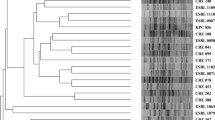Abstract
Susceptibility to 20 antibiotics was tested in 104Stenotrophomonas maltophilia strains at 37 and 30°C by means of a dilution micromethod to verity the phenomenon of temperature-dependent susceptibility (TDS). Trimethoprim-sulfamethoxazole, pefloxacin and ofloxacin were the most active preparations at 37°C (93, 90, and 86% of susceptible strains, respectively), whilst trimethoprim-sulfamethoxazole, cefoperazone-sulbactam and pefloxacin performed best at 30°C (94, 94, and 76% of susceptible strains, respectively). Variants 37TDS (minimum inhibitory concentration, MIC, of tested antibiotics at least 4-times lower at 37 than at 30°C) occurred in 60%. Variants 30TDS (at least 4-times lower value of MIC at 30 than at 37°C) were found in 7.7%. Both variants in susceptibility to tested antibiotics appeared in 23.1%, whilst neither of them was observed in 9.6%. The 37TDS phenomenon was recorded most of all with gentamicin (51% of strains), amikacin (47), colistin (44) and tetracycline (34). The 30TDS phenomenon was found particularly with cefoperazone-sulbactam (16.0% of strains) and colistin (10.0%). The above phenomena may be due to changes in membrane permeability, temperature-dependent ribosomal changes, and insufficient adaptation to higher temperatures of some strains of the originally environmental speciesS. maltophilia.
Similar content being viewed by others
References
Akova M., Bonfiglio G., Livermore D.M.: Susceptibility to β-lactam antibiotics of mutant strains ofXanthomonas maltophilia with high- and low-level constitutive expression of L1 and L2 β-lactamases.J. Med. Microbiol. 35, 208–213 (1991).
Arpi M., Victor M.A., Mortensen I., Gottschau A., Bruun B.:In vitro susceptibility of 124Xanthomonas maltophilia (Stenotrophomonas maltophilia) isolates.Acta Pathol. Microbiol. Immunol. Scand. 104, 108–114 (1996).
Elting L.S., Khardori N., Bodey G.P., Fainstein V.: Nosocomial infection caused byXanthomonas maltophilia: a case-control study of predisposing factors.Infect. Control Hosp. Epidemiol. 11, 134–138 (1990).
Fass R.J., Gregory W.W., D'Amato R.F., Matsen J.M., Wright D.N., Young L.S.:In vitro activities of cefoperazone and sulbactam singly and in combination against cefoperazone-resistant members of the familyEnterobactericeae and non-fermenters.Antimicrob. Agents Chemother. 34, 2256–2259 (1990).
Fass R.J., Barnishan J., Solomon M.C., Ayers L.W.:In vitro activities of quinolones, β-lactams, tobramycin, and trimethoprim-sulfamethoxazole against nonfermentative Gram-negative bacilli.Antimicrob. Agents Chemother. 40, 1412–1418 (1996).
García-Rodríguez J.A., García Sánchez J.E., García García M.I., García Sánchez E., Muñoz Bellido J.L.: Antibiotic susceptibility profile ofXanthomonas maltophilia. In vitro activity of β-lactam/β-lactamase inhibitor combinations.Diagn. Microbiol. Infect. Dis. 14, 239–243 (1991).
Hohl P., Frei R., Aubry P.:In vitro susceptibility of 33 clinical case isolates ofXanthomonas maltophilia. Inconsistent correlation of agar dilution and of disk diffusion test results.Diagn. Microbiol. Infect. Dis. 14, 447–450 (1991).
Holmes B., Pinning C.A., Dawson C.A.: A probability matrix for the identification of Gram-negative, aerobic non-fermentative bacteia that grow on nutrient agar.J. Gen. Microbiol. 132, 1827–1842 (1986).
Holt J.G., Krieg N.R., Sneath P.H.A., Staley J.T., Williams S.T.: Gram-negative aerobic/microaerophilic rods and cocci, pp. 71–174 inBergey's Manual of Determinative Bacteriology, 9th ed. Williams and Wilkins, Baltimor 1994.
Howe R.A., Wilson M.P., Walsh T.R., Millar M.R.: Susceptibility testing ofStenotrophomonas maltophilia to carbapenems.J. Antimicrob. Chemother. 40, 13–17 (1997).
Khardori N., Elting L., Wong E., Schable B., Bodey G.P.: Nosocomial infections due toXanthomonas maltophilia (Pseudomonas maltophilia) in patients with cancer.Rev. Infect. Dis. 12, 997–1003 (1990).
Magee J.T., Hindmarch J.M., Winstanley T.G.: A pyrolysis mass spectrometry study of temperature-dependent compositional shifts inXanthomonas (Pseudomonas) maltophilia.Zbl. Bakt. 285, 299–304 (1997).
National Committee for Clinical Laboratory Standards (NCCLS):Methods for Dilution Antimicrobial Susceptibility Tests for Bacteria that Grow Aerobically: Approved Standard M7-A3, 3rd ed. Villanova (PA) 1993.
Pankuch G.A., Jacobs M.R., Rittenhouse S.F., Appelbaum P.C.: Susceptibilities of 123 strains ofXanthomonas maltophilia to eight β-lactams (including β-lactam-β-lactamase inhibitor combinations) and ciprofloxacin tested by five methods.Antimicrob. Agents Chemother. 38, 2317–2322 (1994).
Rahmati-Bahram A., Magee J.T., Jackson S.K.: Growth temperature-dependent variation of cell envelope lipids and antibiotic susceptibility inStenotrophomonas (Xanthomonas) maltophilia.J. Antimicrob. Chemother. 36, 317–326 (1995)
Rahmati-Bahram A., Magee J.T., Jackson S.K.: Effect of temperature on aminoglycoside binding sites inStenotrophomonas maltophilia.J. Antimicrob. Chemother. 39, 19–24 (1997).
Smith W.J., Boquest A.L., Geddes J.E., Tosolini F.A.: The antibiotic susceptibilities ofXanthomonas maltophilia and their relation to clinical management.Pathology 26, 321–324 (1994).
Vartivarian S., Anaissie E., Bodey G., Sprigg H., Rolston K.: A changing pattern ofXanthomonas maltophilia to antimicrobial agents: implications for therapy.Antimicrob. Agents Chemother. 38, 624–627 (1994).
Wheat P.F., Winstanley T.G., Spencer R.C.: Effect of temperature on antimicrobial susceptibilities ofPseudomonas maltophilia.J. Clin. Pathol. 38, 1055–1058 (1985).
Author information
Authors and Affiliations
Corresponding author
Rights and permissions
About this article
Cite this article
Hejnar, P., Kolář, M., Hájek, V. et al. Occurrence of variants with temperature-dependent susceptibility (TDS) to antibiotics amongStenotrophomonas maltophilia clinical strains. Folia Microbiol 46, 151–155 (2001). https://doi.org/10.1007/BF02873595
Received:
Issue Date:
DOI: https://doi.org/10.1007/BF02873595



